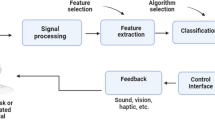Abstract
The investigation of innovative Human-Computer Interfaces (HCI) provides a challenge for future multimedia research and development. Brain-Computer Interfaces (BCI) exploit the ability of human communication and control bypassing the classical neuromuscular communication channels. In general, BCIs offer a possibility of communication for people with severe neuromuscular disorders, such as Amyotrophic Lateral Sclerosis (ALS) or spinal cord injury. Beyond medical applications, a BCI conjunction with exciting multimedia applications, e.g., a dexterity game, could define a new level of control possibilities also for healthy customers decoding information directly from the user’s brain, as reflected in electroencephalographic (EEG) signals which are recorded non-invasively from user’s scalp. This contribution introduces the Berlin Brain–Computer Interface (BBCI) and presents setups where the user is provided with intuitive control strategies in plausible gaming applications that use biofeedback. Yet at its beginning, BBCI thus adds a new dimension in multimedia research by offering the user an additional and independent communication channel based on brain activity only. First successful experiments already yielded inspiring proofs-of-concept. A diversity of multimedia application models, say computer games, and their specific intuitive control strategies, as well as various Virtual Reality (VR) scenarios are now open for BCI research aiming at a further speed up of user adaptation and increase of learning success and transfer bit rates.
Similar content being viewed by others
References
Berger H (1929) Über das Elektroenzephalogramm des Menschen. Archiv Psychiatrischer Nervenkrankheiten 87:527–580
Birbaumer N (1997) Slow cortical potentials: their origin meaning and clinical use. In: Brain and behavior: past, present and future. Tilburg University Press, Tilburg, pp 25–39
Birbaumer N, Ghanayim N, Hinterberger T, Iversen I, Kotchoubey B, Kübler A, Perelmouter J, Taub E, Flor H (1999) Spelling device for the paralyzed. Nature 398:297–298
Blankertz B, Curio G, Müller K-R (2002) Classifying single trial EEG: towards brain computer interfacing. Adv Neural Inf Process Syst 14:157–164
Blankertz B, Dornhege G, Schäfer C, Krepki R, Kohlmorgen J, Müller K-R, Kunzmann V, Losch F, Curio G (2003) Boosting bit rates and error detection for the classification of fast-pace motor commands based on single-trial EEG analysis. IEEE Trans Neural Syst Rehabil Eng 11(2):127–131
Cui RQ, Huter D, Lang W Deecke L (1999) Neuroimage of voluntary movement: topography of the Bereitschaftspotential, a 64-channel DC current source density study. NeuroImage 9:124–134
Donchin E, Smith DB (1970) The contingent negative variation and the late positive wave of the average evoked potential. Electroencephalogr Clin Neurophysiol 29:201–203
Ebrahimi T, Vesin J-M, Garcia G (2003) Brain–computer interface. A new frontier in multimedia communication. IEEE Signal Processing Society–Signal Process Mag 20(1):14–24
Green JB, Sora E, Bialy Y, Ricamato A, Thatcher RW (1999) Cortical motor reorganization after paraplegia: an EEG study. Neurology 53(4):736–743
Hardwick A, Rush J, Furner S, Seton J (1996) Feeling it as well as seeing it. Haptic displays within gestural HCI for multimedia. In: Proceedings of the York Gesture Workshop, University of York, York, Great Britain, March 96, pp 105–116
Harel D, Carmel L, Lancet D (2003) Towards an odor communication system. Computational Biology and Chemistry 27:121–133
Lang W, Zilch O, Koska C, Lindinger G Deecke L (1989) Negative cortical DC shifts preceding and accompanying simple and complex sequential movements. Experiments in Brain Research 74:99–104
MacIntyre B, Feiner S (1996) Future multimedia user interfaces. Multimed Syst J 4(5):250–268
MacKenzie IS (1991) Fitt’s law as a performance model in human–computer interaction. Doctoral dissertation, University of Toronto, Canada
Mika S, Rätsch G, Müller K-R (2001) A mathematical programming approach to the kernel fisher algorithm. Adv Neural Inf Process Syst 13:591–597
Müller K-R, Mika S, Rätsch G, Tsuda K, Schölkopf B (2001) An introduction to kernel-based learning algorithms. IEEE Trans Neural Netw 12(2):181–201
Nicolelis MAL, Chapin JK (2002) Controlling robots with the mind. Sci Am 287(4):46–53
Pantic M, Rothkrantz LJM (2000) Automatic analysis of facial expressions. IEEE Trans Pattern Anal Mach Intell 22(12):1424–1445
Pentland A (1995) Machine understanding of human action. In: Proceedings of the 7th international forum frontier of telecommunication technology, Tokyo, Japan, November 1995, pp.757–764
Pfurtscheller G (1999) EEG event-related desynchronization (ERD) and event-related synchronization (ERS). In: Electroencephalography: basic principals, clinical applications and related fields, 4th edn. Williams and Wilkins, Baltimore, MD, pp 958–967
Pfurtscheller G, Flotzinger D, Kalcher J (1993) Brain–computer interface. A new communication device for handicapped persons. J Microcomput Appl 16:293–299
Sharbrough F, Chatrian G-E, Lesser RP, Lüders H, Nuwer M, Picton TW (1991) American Electroencephalographic Society guidelines for standard electrode position nomenclature. J Clin Neurophysiol 8:200–202
Sutter EE (1992) The brain response interface: communication through visually induced electrical brain responses. J Microcomput Appl 15:31–45
Vapnik V (1995) The nature of statistical learning theory. Springer, Berlin Heidelberg New York
Wolpaw JR, McFarland DJ, Neat GW, Forneris GW (1991) An EEG-based brain–computer interface for cursor control. Electroencephalogr Clin Neurophysiol 78:252–259
Wolpaw JR, Birbaumer N, McFarland DJ, Pfurtscheller G, Vaughan TM (2002) Brain–computer interfaces for communication and control. Clin Neurophysiol 113:767–791
Krepki R (2004) Brain-Computer Interfaces. Design and implementation of an online BCI-System for the control in gaming applications and virtual limbs. Doctoral dissertation, Technical University of Berlin, Germany
Author information
Authors and Affiliations
Corresponding author
Additional information
Manuscript received on November the 25th, 2003. This work was supported by a grant of the Bundesministerium für Bildung und Forschung (BMBF), FKZ 01IBB02A and 01IBB02B.
Rights and permissions
About this article
Cite this article
Krepki, R., Blankertz, B., Curio, G. et al. The Berlin Brain-Computer Interface (BBCI) – towards a new communication channel for online control in gaming applications. Multimed Tools Appl 33, 73–90 (2007). https://doi.org/10.1007/s11042-006-0094-3
Published:
Issue Date:
DOI: https://doi.org/10.1007/s11042-006-0094-3




